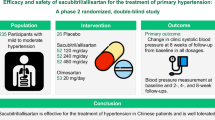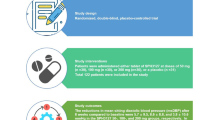Abstract
The objective of this Phase III double-blind parallel-group controlled study was to examine the superiority of amlodipine 10 mg once daily (the amlodipine 10 mg group) to amlodipine 5 mg once daily (the amlodipine 5 mg group) in 305 Japanese outpatients with essential hypertension whose systolic blood pressure (SBP) had not reached the therapeutic target levels (<130–140/80–90 mm Hg) when treated with amlodipine 5 mg once daily. This study consisted of the 1-week prescreening, 8-week screening and 8-week double-blind periods. Changes in trough SBP from baseline at week 8 of the double-blind period (week 8) were −7.0 mm Hg and −13.7 mm Hg in the amlodipine 5 and 10 mg groups, respectively; a significant difference (P<0.001) was found between the two groups. Changes in trough diastolic blood pressure (DBP) from baseline at week 8 were −2.7 mm Hg and −6.8 mm Hg in the amlodipine 5 and 10 mg groups, respectively, with a significant difference (P<0.001) between the two groups. At week 8, responder rates were 28.5 and 44.0% in the amlodipine 5 mg and 10 mg groups, respectively, with a significant difference (P=0.002) between the two groups. The amlodipine 10 mg group showed no significant difference in the incidences of adverse events against the amlodipine 5 mg group. The incidence of mild peripheral oedema was 4% only in the amlodipine 10 mg group. In conclusion, amlodipine 10 mg once daily was found to be superior to amlodipine 5 mg once daily, safe, well tolerated and useful for the relevant subjects.
This is a preview of subscription content, access via your institution
Access options
Subscribe to this journal
Receive 12 digital issues and online access to articles
$119.00 per year
only $9.92 per issue
Buy this article
- Purchase on Springer Link
- Instant access to full article PDF
Prices may be subject to local taxes which are calculated during checkout


Similar content being viewed by others
References
Omvik P, Thaulow E, Herland OB, Eide I, Midha R, Ralph RT . Double-blind, parallel, comparative study on quality of life during treatment with amlodipine or enalapril in mild or moderate hypertensive patients: a multicentre study. J Hypertens 1993; 11: 103–113.
Katayama S, Inaba M, Morita T, Awata T, Shimamoto K, Kikkawa R . Blood pressure control in Japanese hypertensives with or without type 2 diabetes Mellitus. Hypertens Res (236); 2000: 601–605.
The Antihypertensive and Lipid-Lowering Treatment to Prevent Heart Attack Trial (ALLHAT). Major outcomes in high-risk hypertensive patients randomized to angiotensin-converting enzyme inhibitor or calcium channel blocker vs. diuretic. JAMA 2002; 288: 2981–2997.
Julius S, Kjeldsen SE, Weber M, Brunner HS, Ekman S, Hansson L et al. Outcomes in hypertensive patients at high cardiovascular risk treated with regimens based on valsartan or amlodipine: the VALUE randomized trial. Lancet 2004; 363: 2022–2031.
Dahlof B, Sever PS, Poulter NR, Wedel H, Beevers DG, Caulfield M et al. Prevention of cardiovascular events with an antihypertensive regimen of amlodipine adding perindopril as required versus atenolol adding bendroflumethiazide as required in the Anglo-Scandinavian Cardiac Outcomes Trial-Blood Pressure Lowering Arm (ASCOT-BPLA): a multicentre randomised controlled trial. Lancet 2005; 366: 895–906.
Taylor SH, Chen M, Lee SJK, Koanantakul B, Zhu JR, Santoso T et al. Efficacy and tolerability of amlodipine in the general practice treatment of essential hypertension in an Asian multinational population. Clin Drug Invest 1998; 16: 177–185.
Tomlinson B, Woo J, Thomas GN, Chau YM, Critchley JA . Randomized, controlled parallel-group comparison of ambulatory and clinic blood pressure responses to amlodipine or enalapril during and after treatment in adult Chinese patients with hypertension. Clin Ther 2004; 26: 1292–1304.
Wang X, Gong L, Guo J . Parallel comparative trial of amlodipine and nitrendipine monotherapy in patients with essential hypertension. J Hypertens 1998; 16 (suppl. 4): S43–S47.
Wu SC, Liu CP, Chiang HT, Lin SL . Prospective and randomized study of the antihypertensive effect and tolerability of three antihypertensive agents, losartan, amlodipine, and lisinopril, in hypertensive patients. Heart Vessels 2004; 19: 13–18.
Cheung BMY, Lau C, Wu B . Amlodipine, felodipine, and isradipine in the treatment of Chinese patients with mild-to-moderate hypertension. Clin Ther 1998; 20: 1159–1169.
Lau CP, Cheung BMY . Relative efficacy and tolerability of lacidipine and amlodipine in patients with mild-to-moderate hypertension: a randomized double-blind study. J Cardiovasc Pharmacol 1996; 28: 328–331.
Ding YA, Chang SM, Chou TC . Comparison of the effect of amlodipine and quinapril on ambulatory blood pressure in hypertension. J Hum Hypertens 1995; 9: 637–641.
Ko GTC, Chan HCK, Chan CHS . Blood pressure reduction and tolerability of amlodipine versus nifedipine retard in Chinese patients with type 2 diabetes mellitus and hypertension: a randomized 1-year clinical trial. Int J Clin Pharmacol Ther 2001; 39: 331–335.
Hwang JJ, Chen JJ . Once-daily amlodipine on ambulatory blood pressure and regression of left ventricular hypertrophy in patients with mild to moderate essential hypertension. JAMA SE Asia 1995; 11 (Suppl 4): 10–15.
Packer M, O'Connor CM, Ghali JK, Pressler ML, Carson PE, Belkin RN et al. Effect of amlodipine on morbidity and mortality in severe chronic heart failure. N Engl J Med 1996; 335: 1107–1114.
Pitt B, Byington RP, Furberg CD, Hunninghake DB, Mancini GBJ, Miller ME et al. Effect of amlodipine on the progression of atherosclerosis and the occurrence of clinical events. Circulation 2000; 102: 1503–1510.
Chobanian AV, Bakris GL, Black HR, Cushman WC, Green LA, Izzo Jr JL et al. The national high blood pressure education program coordination committee on prevention, detection, evaluation, and treatment of high blood pressure. JAMA 2003; 289: 2560–2572.
Guideline Committee. 2003 European Society of Hypertension-European Society of Cardiology guidelines for the management of arterial hypertension. J Hypertens 2003; 21: 1011–1053.
Abernethy DR, Schwartz JB . Calcium-antagonist drugs. N Engl J Med 1999; 341 (19): 1447–1457.
Brown MJ, Palmer RC, Castaigne A, de Leeuw PW, Mancia G, Rosenthal T et al. Morbidity and mortality in patients randomized to double-blind treatment with a long-acting calcium-channel blocker or diuretic in the International Nifedipine GITS study: Intervention as a Goal in Hypertension Treatment (INSIGHT). Lancet 2000; 356: 366–372.
Hansson L, Lindholm LH, Ekbom T, Dahof B, Lanke J, Schersten B et al. Randomised trial of old and new antihypertensive drugs in elderly patients: cardiovascular mortality and morbidity the Swedish Trial in old patients with hypertension-2 study. Lancet 1999; 354: 1751–1756.
Ogihara T, Nakao K, Fukui T, Fukiyama K, Ueshima K, Oba K et al. Effects of candesartan compared with amlodipine in hypertensive patients with high cardiovascular risks. Hypertension 2008; 51: 393–398.
Acknowledgements
We thank Dr Satoshi Sakima for his valuable suggestions and critical review of the article.
List of study participants
A Okano, (Okano Clinic), K Yamada, (Kousei Medical Clinic), T Arino, (Yamaichi Bldg. Medical Clinic), A Kubo (Kubo Clinic), H Tajima (Tajima Clinic), Y Yamane (Toyooka Daiichi Hospital), T Ohmi (Shonan Ochanomizu Clinic), Y Nakamura (Kitanodori Medicine Clinic), M Koizumi (Koizumi Pulmonology and Internal Medicine Clinic), T Miura (Miyanosawa General Clinic), M Yamauchi (Yamanouchi Medical Clinic), T Murakami (Shimo-Kitazawa Tomo Clinic), T Sakakibara (Sakakibara Clinic, Wakaumekai Medical Corporation), S Tamura (Tamura Medical Clinic), H Ikematsu, (Haradoi Hospital), K Dohmen, (Okabe Hospital), K Egashira (Sakura Hospital), H Harada (Harada Clinic), T Doi (Doi-Naika Clinic), K Gondo (Gondo Clinic), T Nakamura (Nakamuratadashi Naikajunkankika Clinic), Y Momiyama, (National Hospital Organization, Tokyo Medical Center), R Katabuchi, MD (National Hospital Organization, Fukuoka-Higashi Medical Center).
Pfizer Inc.
• Clinical Research Division: T Fujiwara (project leader), M Murakami
• Data Management Department: T Watanabe
• Clinical Pharmacology: N Kimura
• Statistics and Analysis Department: J Hatsuzawa and Y Ii
• Clinical Study Management Department: H Murase
Author information
Authors and Affiliations
Corresponding author
Rights and permissions
About this article
Cite this article
Fujiwara, T., Ii, Y., Hatsuzawa, J. et al. The Phase III, double-blind, parallel-group controlled study of amlodipine 10 mg once daily in Japanese patients with essential hypertension who insufficiently responded to amlodipine 5 mg once daily. J Hum Hypertens 23, 521–529 (2009). https://doi.org/10.1038/jhh.2008.161
Received:
Revised:
Accepted:
Published:
Issue Date:
DOI: https://doi.org/10.1038/jhh.2008.161
Keywords
This article is cited by
-
The effects of increasing calcium channel blocker dose vs. adding a diuretic to treatment regimens for patients with uncontrolled hypertension
Hypertension Research (2017)
-
Efficacy and safety of the dual L- and T-type calcium channel blocker, ACT-280778: a proof-of-concept study in patients with mild-to-moderate essential hypertension
Journal of Human Hypertension (2015)
-
Nifedipine controlled-release 40 mg b.i.d. in Japanese patients with essential hypertension who responded insufficiently to nifedipine controlled-release 40 mg q.d.: a phase III, randomized, double-blind and parallel-group study
Hypertension Research (2014)



